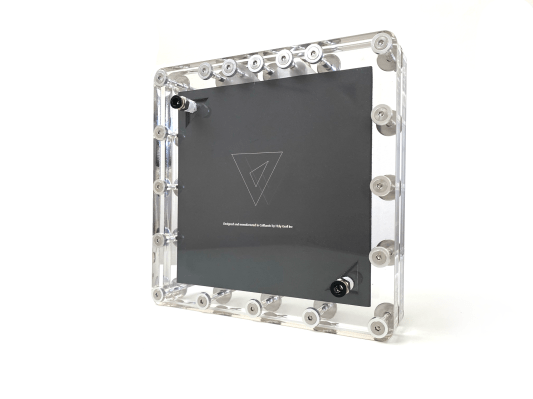The founders of Holy Grail, a two-year-old startup based in Mountain View, California, are taking a micro approach to solving the outsized problem of capturing carbon.
The startup is prototyping a direct air carbon capture device that is modular and small — a departure from the dozens of projects in the U.S. and abroad that aim to capture CO2 from large, centralized emitters, like power plants or industrial facilities. Holy Grail co-founder Nuno Pereira told TechCrunch that this approach will reduce costs and eliminate the need for permits or project financing.
While Holy Grail has a long development and testing phase ahead, the idea has captured the attention and capital from well-known investors and Silicon Valley founders. Holy Grail recently raised $2.7 million in seed funding from LowerCarbon Capital, Goat Capital, Stripe founder Patrick Collison, Charlie Songhurst, Cruise co-founder Kyle Vogt, Songkick co-founder Ian Hogarth, Starlight Ventures and 35 Ventures. Existing investors Deep Science Ventures, Y Combinator and Oliver Cameron, who co-founded Voyage, the autonomous vehicle acquired by Cruise, also participated.
The carbon capture device is still in the prototype stage, Pereira said, with many specifics — such as the anticipated size of the end product and how long it will likely function — still to be worked out. Cost-effectively separating CO2 from the air is an extremely difficult problem to solve. The company is in the process of filing patents for the technology, so he declined to be too specific about many characteristics of the device, including what it will be made out of. But he did stress that the company is taking a fundamentally different technical approach to carbon capture.
“The current technologies, they are very complex. They are basically either [using] temperature or pressure [to capture carbon],” he said. “There is a lot of things that go into it, compressors, calciners and all these things,” referring to additional parts like mechanical pumps, cryogenic air separators and large quantities of water and energy. Pereira said the company will instead use electricity to control a chemical reaction that binds to the CO2. He added that Holy Grail’s devices are not dependent on scale to achieve cost reductions, either. And they will be modular, so they can be stacked or configured depending on a customer’s requirements.
The scrubbers, as Pereira calls them, will focus on raw capture of CO2 rather than conversion (converting the CO2 into fuels, for example). Pereira instead explained — with a heavy caveat that much about the end product still needs to be figured out — that once a Holy Grail unit is full, it could be collected by the company, though where the carbon will end up is still an open question.
The company will start by selling carbon credits, using its devices as the carbon reducing project. The end goal is selling the scrubbers to commercial customers and eventually even individual consumers. That’s right: Holy Grail wants you to have your own carbon capture device, possibly even right in your backyard. But the company still likely has a long road ahead of it.
“We’re essentially shifting the scaling factor from building a very large mega-ton plant and having the project management and all that stuff to building scrubbers in an assembly line, like a consumer product to be manufactured.”
Pereira said many approaches will be needed to tackle the mammoth problem of reducing the amount of CO2 in the atmosphere. “The problem is just too big,” he said.
The story has been updated to reflect that Holy Grail is based in Mountain View, not Cupertino.


Recent Comments